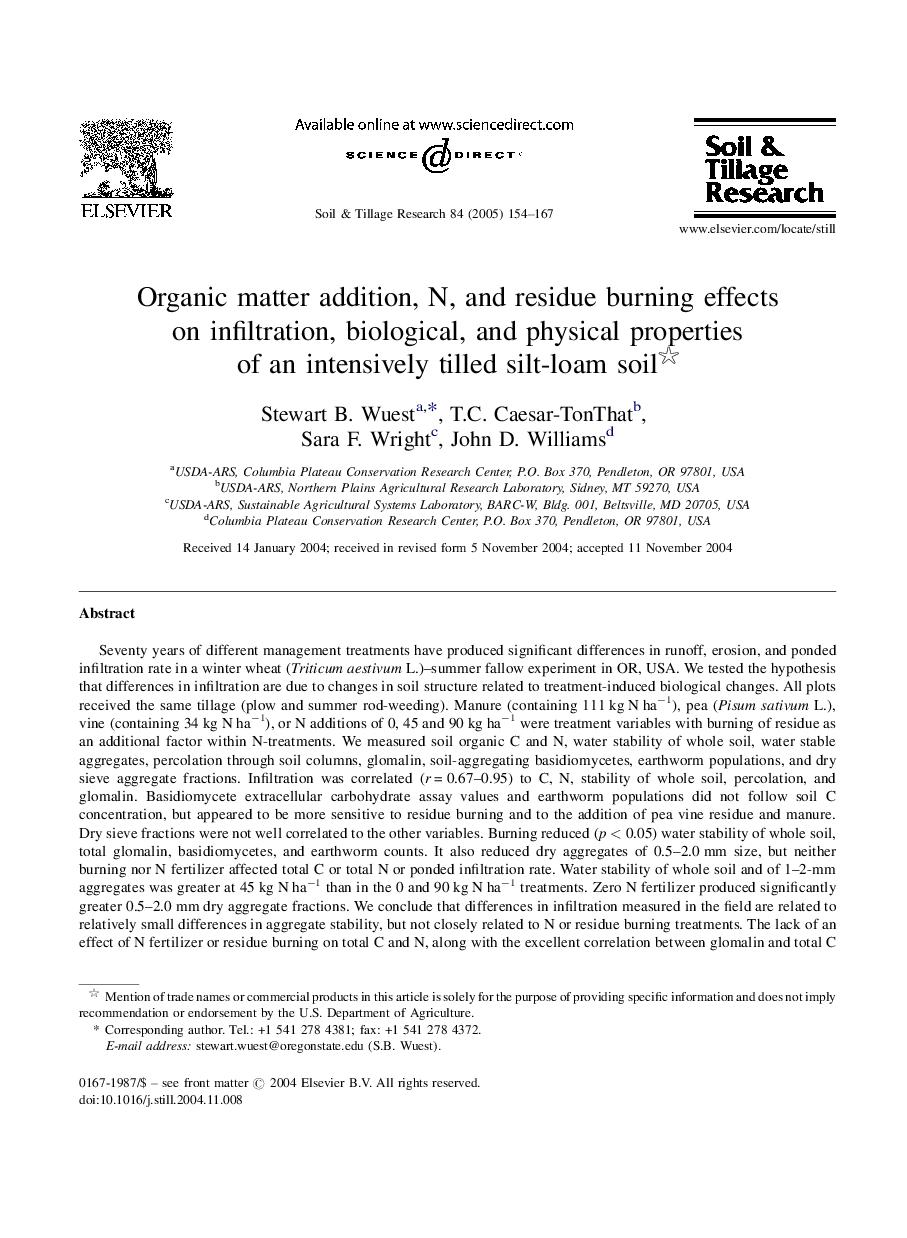| کد مقاله | کد نشریه | سال انتشار | مقاله انگلیسی | نسخه تمام متن |
|---|---|---|---|---|
| 10295285 | 513120 | 2005 | 14 صفحه PDF | دانلود رایگان |
عنوان انگلیسی مقاله ISI
Organic matter addition, N, and residue burning effects on infiltration, biological, and physical properties of an intensively tilled silt-loam soil
دانلود مقاله + سفارش ترجمه
دانلود مقاله ISI انگلیسی
رایگان برای ایرانیان
کلمات کلیدی
موضوعات مرتبط
مهندسی و علوم پایه
مهندسی انرژی
انرژی های تجدید پذیر، توسعه پایدار و محیط زیست
پیش نمایش صفحه اول مقاله

چکیده انگلیسی
Seventy years of different management treatments have produced significant differences in runoff, erosion, and ponded infiltration rate in a winter wheat (Triticum aestivum L.)-summer fallow experiment in OR, USA. We tested the hypothesis that differences in infiltration are due to changes in soil structure related to treatment-induced biological changes. All plots received the same tillage (plow and summer rod-weeding). Manure (containing 111 kg N haâ1), pea (Pisum sativum L.), vine (containing 34 kg N haâ1), or N additions of 0, 45 and 90 kg haâ1 were treatment variables with burning of residue as an additional factor within N-treatments. We measured soil organic C and N, water stability of whole soil, water stable aggregates, percolation through soil columns, glomalin, soil-aggregating basidiomycetes, earthworm populations, and dry sieve aggregate fractions. Infiltration was correlated (r = 0.67-0.95) to C, N, stability of whole soil, percolation, and glomalin. Basidiomycete extracellular carbohydrate assay values and earthworm populations did not follow soil C concentration, but appeared to be more sensitive to residue burning and to the addition of pea vine residue and manure. Dry sieve fractions were not well correlated to the other variables. Burning reduced (p < 0.05) water stability of whole soil, total glomalin, basidiomycetes, and earthworm counts. It also reduced dry aggregates of 0.5-2.0 mm size, but neither burning nor N fertilizer affected total C or total N or ponded infiltration rate. Water stability of whole soil and of 1-2-mm aggregates was greater at 45 kg N haâ1 than in the 0 and 90 kg N haâ1 treatments. Zero N fertilizer produced significantly greater 0.5-2.0 mm dry aggregate fractions. We conclude that differences in infiltration measured in the field are related to relatively small differences in aggregate stability, but not closely related to N or residue burning treatments. The lack of an effect of N fertilizer or residue burning on total C and N, along with the excellent correlation between glomalin and total C (r = 0.99) and total N (r = 0.98), indicates that the major pool of soil carbon may be dependent on arbuscular mycorrhizal fungi.
ناشر
Database: Elsevier - ScienceDirect (ساینس دایرکت)
Journal: Soil and Tillage Research - Volume 84, Issue 2, December 2005, Pages 154-167
Journal: Soil and Tillage Research - Volume 84, Issue 2, December 2005, Pages 154-167
نویسندگان
Stewart B. Wuest, T.C. Caesar-TonThat, Sara F. Wright, John D. Williams,